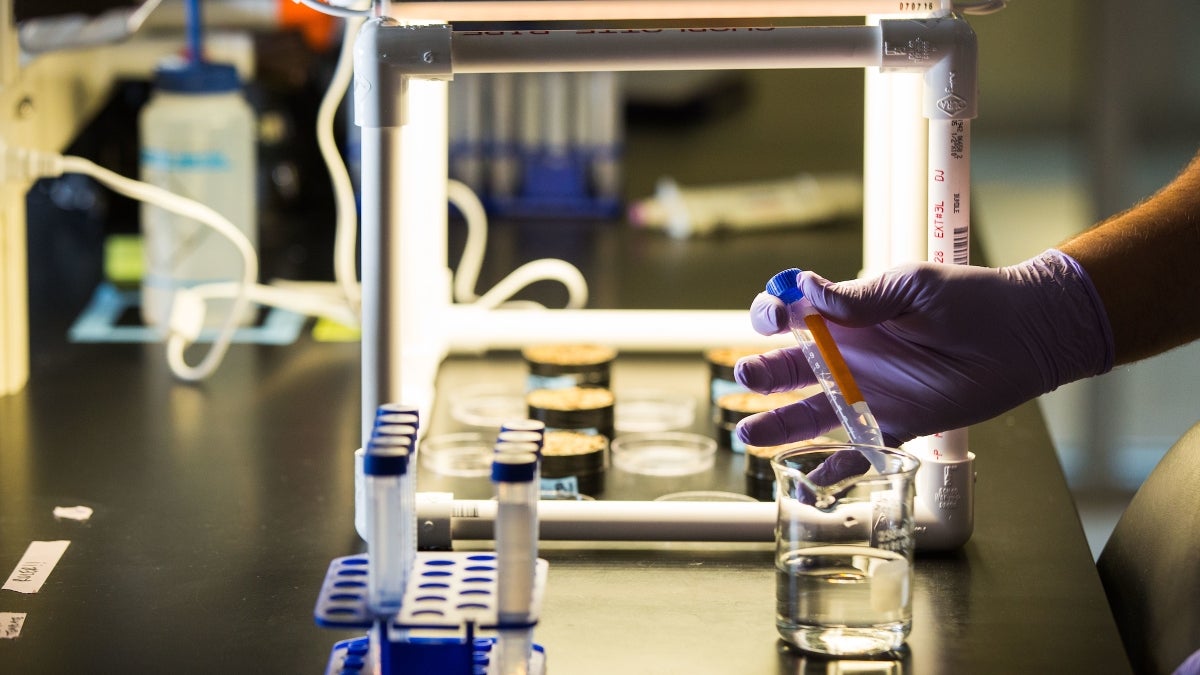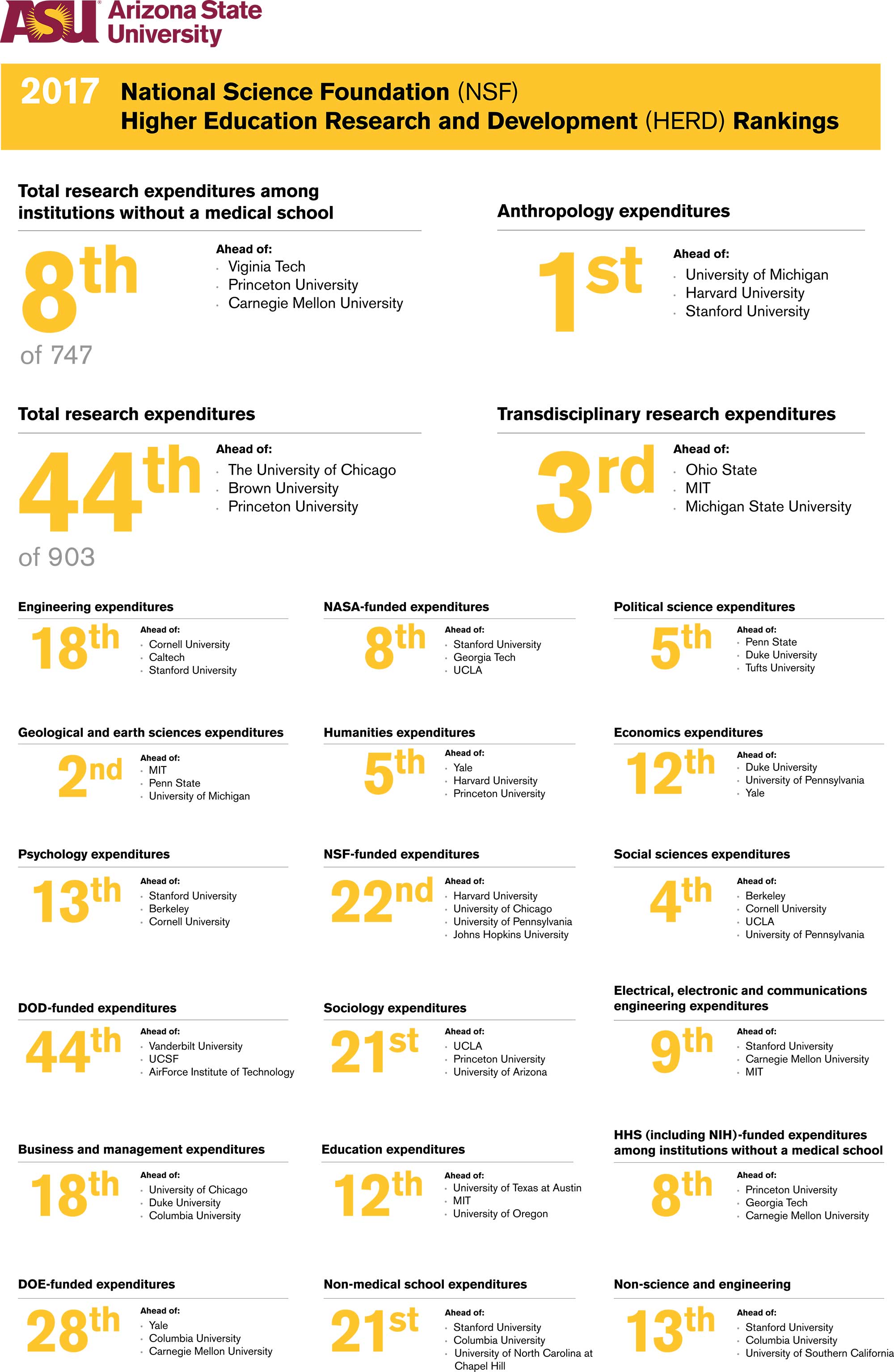Continuing on its path as a rapidly growing research enterprise, Arizona State University reported $545 million in research expenditures for fiscal year 2017, up from $518 million in FY16, according to a recent report by the U.S. National Science Foundation. ASU is holding its rank at No. 44 for total research expenditures in the U.S., remaining ahead of the California Institute of Technology and the University of Chicago. Among institutions without a medical school, ASU moved up one spot to No. 8, ahead of Princeton University and Carnegie Mellon University.
In addition, ASU announced that its research expenditures for FY18 now total more than $600 million — a first for the university.
The NSF’s FY17 Higher Education Research and Development (HERD) rankings, its most recent report based on FY17 expenditures, has ASU holding a strong lead among all reporting institutions, including a No. 1 ranking in anthropology expenditures, ahead of Harvard and Stanford universities.
ASU ranks No. 2 in geological and earth sciences, ahead of Stanford University, MIT and Penn State; and ranks No. 3 for transdisciplinary research expenditures, ahead of Ohio State, MIT and Michigan State University. ASU also made significant gains in rankings for expenditures in metallurgical and materials engineering, physics, and visual and performing arts, according to the HERD report.
“For the past 16 years, ASU’s research expenditures have grown exponentially, often exceeding goals and defying expectations,” said Sethuraman Panchanathan, executive vice president of Knowledge Enterprise Development and chief research and innovation officer at ASU. “Surpassing $600 million represents the latest benchmark in our journey to advance knowledge worldwide and translate high-quality research into tangible, actionable solutions.”
Funding research initiatives
ASU receives research funding through several avenues, including businesses and nonprofits, as well as federal, state and local grants.
Since 2002, ASU’s research enterprise has seen enormous growth. The university secured a number of prestigious grant awards from federal institutions, including the U.S. Department of Energy, NASA and the Department of Defense. To support this growth, ASU launched several interdisciplinary initiatives, providing a framework for researchers to build teams that can solve complex global challenges.
For example, ASU’s Biodesign Institute, which launched in 2004, focuses on interdisciplinary research approaches to global health, security and sustainability. Since its inception, Biodesign Institute has attracted more than $740 million in funding.
ASU’s Global Security Initiative, launched in 2015, addresses global security challenges through interdisciplinary research. The team recently received a $20 million award from the Department of Homeland Security to develop tools to improve operations in the department’s component organizations, including the Transportation Security Administration, U.S. Coast Guard, Federal Emergency Management Agency and Customs and Border Protection.
In 2004, ASU established the Julie Ann Wrigley Global Institute of Sustainability. The institute is the hub of ASU’s sustainability initiatives and research. Experts from a range of disciplines in the natural and social sciences, medicine, engineering, mathematics, humanities and the arts work to solve global sustainability problems. In FY17, sustainability scientists and scholars across ASU accounted for $93 million in research expenditures.
Access and education
ASU’s growing research enterprise provides students with invaluable, real-world experience. For Alexandra Hawes, a sophomore studying aerospace engineering, this means a job as a research aide supporting the $760 million ASU-led NASA Psyche Mission.
Psyche is an asteroid orbiting the sun between Mars and Jupiter. ASU is leading the Psyche Mission, which will launch in 2022, travel to the asteroid and, upon arrival in 2026, give scientists the first up-close view of an all-metal world.
“I will be able to take my experience with developing the remote-sensing controls for the unmanned Psyche spacecraft and apply that to developing remote sensing and navigational control systems for manned space flights in the future,” Hawes said. “Working on the project has helped me understand that NASA leads, partners with, contracts with and cooperates with private- and public-sector organizations, and other nations, to explore space and ultimately expand humankind’s understanding of our role in the universe. For me, working on a NASA mission fulfills my goals to gain technical, interpersonal and leadership skills for my career.”
For Michael Steptoe, a doctoral student studying visualization and predictive analytics in the Ira A. Fulton Schools of Engineering, ASU’s transdisciplinary structure has been vital to his education.
“When I was an undergraduate, I had no idea what visualization even was, or that it was this hot research field,” Steptoe said. “It was huge for me to learn about it and go into this field. My work allows me to look at data sources and build out decision systems so that decision makers can make informed choices and policy.”
Steptoe is currently working with ASU’s Global Security Initiative on its Department of Homeland Security project.
History
In 2002, ASU’s expenditures totaled $123 million. Since then, ASU’s research enterprise remains as one of the fastest growing among universities.
Overall, the university has seen extensive growth in sociology, political science, biological sciences, engineering, earth sciences, economics and psychology research.
“Through the application of a comprehensive, strategic approach, we expanded our research footprint while continuing to advance interdisciplinary collaboration that enables our researchers to secure funding and solve global grand challenges,” Panchanathan said. “Our faculty, students and staff are integral to this growth, tirelessly seeking new opportunities for research and discovery.”
The future
ASU is well on its way to its goal of expanding the university’s research enterprise to $815 million in expenditures by 2025.
A key element to research growth is building advanced and appropriate lab space. ASU has built several advanced research buildings. The latest is the five-story, 191,000 square-foot Biodesign C building, which opened in the fall of 2018. Biodesign C will be home to 80 lead researchers and 400 support staff. Scientists there will tackle major health care and environmental societal issues through its multidisciplinary research centers, including the ASU-Banner Neurodegenerative Disease Research Center, the Biodesign Center for Applied Structural Discovery, the Biodesign Center for Mechanisms of Evolution and several labs from ASU’s School of Molecular Sciences. A new research tool will be completed in the year ahead — the world’s first compact X-ray free-electron laser — a key instrument that can unlock the interaction of molecules and be used in drug discovery and energy research.
Along with expanded research space, ASU also is adding star researchers to its faculty.
ASU’s Center for Global Discovery and Conservation Science will launch in 2019. Greg Asner, who will join ASU in January from the Carnegie Institution for Science, Washington D.C., will lead the center.
Asner has been a leader in airborne mapping techniques that help reveal functional diversity and vulnerabilities of various ecosystems and identify targets for conservation. Asner was elected to the U.S. National Academy of Sciences (2013) and is a fellow of the American Geophysical Union (2015) and of the Ecological Society of America (2016).
Kathleen Merrigan, former U.S. Deputy Secretary of Agriculture and a leader of sustainable food systems, was named the first executive director of ASU’s Swette Center for Sustainable Food Systems in fall 2018. Merrigan brings decades of experience in agriculture, sustainability and food systems to ASU, which will strengthen ASU’s global impact on research, policy and education.
“I joined ASU because of its commitment to inclusivity and collaboration,” Merrigan said. “Soaring rankings and research prowess stem from our dedication to public values. Together with our students, we are designing solutions to society’s most pressing challenges. The work is important and energizing. We are solving problems.”
Top photo by Deanna Dent/ASU Now
More University news

ASU establishes Center for Free Speech, will host annual free speech forum
Arizona State University is establishing a new Center for Free Speech to encourage the uninhibited exchange of ideas, and the university will launch an annual free speech forum that will begin in…

Public affairs professor, back at ASU after 3 years with NSF, is named Sackton Chair
After three years at the National Science Foundation, Professor Mary Feeney has returned to Arizona State University, where she intends to help early-career women and women of color succeed in…

A decade strong: ASU takes top spot in innovation for 10th year in a row
For the 10th year in a row, Arizona State University is No. 1 in innovation in the newly released annual “Best Colleges” 2025 rankings by U.S. News & World Report — just one of many top rankings…

